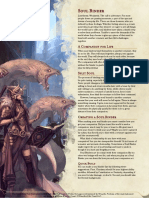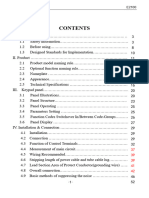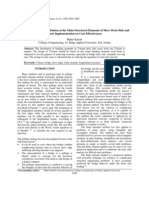Emt Poster
Emt Poster
Uploaded by
DrThant Zin TunCopyright:
Available Formats
Emt Poster
Emt Poster
Uploaded by
DrThant Zin TunCopyright
Available Formats
Share this document
Did you find this document useful?
Is this content inappropriate?
Copyright:
Available Formats
Emt Poster
Emt Poster
Uploaded by
DrThant Zin TunCopyright:
Available Formats
Emergency Medical Technician Decision Tree Flow Chart
UNSAFE!
1 - SCENE SIZE-UP
1) Take the necessary Body Substance Isolation precautions 2) Assure Scene Safety for rescuer, patient, and bystanders 3) Determine Mechanism of Injury or Nature of Illness 4) Establish Number of Patients 5) Need for Additional Resources
SAFE
Control Scene Move Patients Correct Hazzard
TRAUMA Patient
Suspect Spinal Injury? NO Assess Mental Status (AVPU) YES
MOI
2INITIAL PATIENT ASSESSMENT
Form General Impression: Mechanism of Injury? Look, Feel Skins, Listen Breathing, L.O.C. DECIDE: TRAUMA, MEDICA, BOTH ? (A,B,Cs, Bleed and Shock)
MED
MEDICAL Patient
Establish In-line Stabilization
Assess Mental Status (AVPU) CLOSED Perform Jawthrust Manuver DECAP BTLS: Deformity Evisceration Contusion Abrasion Penetration Burns Tenderness Lacerations Swelling PMS: Pulse/Capalary Rel Motor Function Sensation PEARL: Pupils Equal And Reactive to Light JVD: Jugular Vein Distention SAMPLE: Signs and Symptoms, Allergies, Medications, Past History, Last Oral Intake, Environment OPQRST: Onset, Provocation, Quality of pain, Radiation and Severity of pain, Time (Interventions) PRBELLS: Pulse, Respiration, Blood Pressure, Eyes, Lung Sounds, LOC, Skins LOC: Level of Consciousness CLOSED Head-Tilt, Chin-Lift
Assess Airway O P E N Assess Breathing A D E Q U A T E Assess Circulation P U L S E
Assess Airway O P E N Assess Breathing A D E Q U A T E Assess Circulation P U L S E ASSESS SKINS EYES
INADEQUATE Begin Positive Pressure Ventilation with Supplemental Oxygen
INADEQUATE Begin Positive Pressure Ventilation with Supplemental Oxygen
NO PULSE
NO PULSE
BEGIN CPR
BEGIN CPR
APPLY AED Assess Bleeding BLEEDING
APPLY AED
NONE ASSESS SKINS P.M.S.
CONTROL BLEEDING
TRANSPORT
TRANSPORT
3 - Focused History and Physical Exam
UNCONSCIOUS or Obvious Injury
3 - Focused History and Physical Exam
LOC 3+
RECONSIDER THE MECHANISM OF INJURY
ALERT & Uninjured
CONSIDER MENTAL STATUS
Altered
Signicant MOI, Mutiple Injuries, or Altered Mental Status Continue Inline Stabilization Continually Reassess Mental Status Perform RAPID Trauma Assessment Consider Advance Life Support Resources? Reconsider Transport Decision? Take Baseline Vital Signs: PRBELLS Record SAMPLE History: PUAHA
No signicant MOI, Single injury, or Alert Mental Status
Responsive Assess Complaints Signs and Symptoms (OPQRST) Record History: Signs and Symptoms, Alergies, Medications, Past Mediacl History, Last Oral Intake, and any Envioronmental Conditions. Perform a Focused Medical Assessment Take Baseline Vital Signs: PRBELLS Consider Transport Decision? YES
Unresponsive
Perform Focused History and Physical Exam
Perform a RAPID Medical Assessment
Take Baseline Vital Signs: PRBELLS
Take Baseline Vital Signs: PRBELLS
Record History: Signs and Symptoms, Alergies, Medications, Past Mediacl History, Last Oral Intake, and any Envioronmental Conditions.
Position Patient
Record SAMPLE History:
Perform Needed Components of a Detailed Physical Exam
TRANSPORT
NO
TRANSPORT
4 - Detailed Physical Exam
Alert
RECONSIDER MENTAL STATUS
Declining
Responsive
Unresponsive Position Patient Assess the HEAD: Feel for soft spots, DECAPBTLS Assess the EARS: Look for Fluid
Perform Components of Detailed Physical Exam based on patients's Injuries and Complaints
Assess the FACE: Look for Asymmetry: DECAPBTLS Assess the EYES: PEARL, Colors, Symmetry Assess the NOSE: Fluid, Symmetry, Air ow Assess the MOUTH: Teeth, Tung, Lips, Throat Assess the NECK: JVD, Tracheal Deviation, C-SPINE Assess the CHEST: Paradoxical Movement, DECAPBTLS Assess the ABDOMEN: 4-Quadrents, DECAPBTLS Assess the PELVIS: Asymmetrical movement, Genitals Assess the EXTREMITIES: PMS, DECAPBTLS, Asymmetry
Reassess Vital Signs: Pulse, Respiration, Blood Pressure, Eyes, LOC, Last Oral Intake, Skins
KEY
# Section
Decision ?
Assess the POSTERIOR BODY: Spinal line, DECAPBTLS Reassess Vital Signs: PRBELLS
Symptom
ACTION
Procedure
5 - Ongoing Assessment
REPEAT INITIAL ASSESSMENT REASSESS: General Impression, Mental Status, Airway, Breathing Rate and Quality, Circulation; Pulse Rate and Quality, Skin Color, Temperature, Condition, Bleeding. Reestablish Patient Priority
Loop
TRAUMA AREA
MEDICAL AREA
Worse Repeat Focused History and Physical Exam Provide Emergency Care Assess Effectiveness of Emergency Care Reassess Vital Signs Every 5 min.
Change in Patient Condition?
Stable Reassess Vital Signs Reassess Emergency Care
REPEAT Ongoing Assessment
6 - Communication and Documentation
During your call you will communicate, at important points, with dispatch and with medical direction as well as with the staff of the medical facility to which you transport the patient. You must also communicate clearly with other EMS personnel, the patient, and others at the scene. A failure of clear communication - both in what they communicate to you or in what you communicate to others - can have a signicant effect upon the quality of assessment and care you and others provide. In addition a signicant portion of the value of patient assessment and care is lost if what you have learned about the patient's condition and the care you have given are not clearly and adequately documented in written reports.
Emergency Medical Technition Decision Tree and NR-EMT Study Guide
A product of Lifeguard Adventures.com, Copyright 2007 1666 Garnet, #619, San Diego, CA 92109 (619) 206-4361, Toll Free (888) 2-Swim-Safe INFO@LifeguardAdventures.com
You might also like
- Synthetic Indices Guide On Minimum LotsizeDocument4 pagesSynthetic Indices Guide On Minimum Lotsizesandvma50% (2)
- EMT (Emergency Medical Technician) Crash Course Book + OnlineFrom EverandEMT (Emergency Medical Technician) Crash Course Book + OnlineRating: 4.5 out of 5 stars4.5/5 (4)
- 60 Second EMTDocument29 pages60 Second EMTstripec30No ratings yet
- NIH Stroke Scale BookletDocument11 pagesNIH Stroke Scale Bookletcleber333100% (2)
- EMT Basic Practice ExamDocument208 pagesEMT Basic Practice ExamLuis Ferdinand Dacera-Gabronino Gamponia-Nonan92% (13)
- EMT Basic Sample Questions PrintableDocument8 pagesEMT Basic Sample Questions Printableeyadkasho100% (3)
- The Basics: A Comprehensive Outline of Nursing School ContentFrom EverandThe Basics: A Comprehensive Outline of Nursing School ContentRating: 5 out of 5 stars5/5 (3)
- LSTI EMT-B ManualDocument189 pagesLSTI EMT-B ManualCraig Barrett100% (16)
- Using SoapDocument1 pageUsing SoapMichael Wilson50% (2)
- Batching of Concrete Method StatementDocument4 pagesBatching of Concrete Method Statementvertigo100% (4)
- Back to Basics: Critical Care Transport Certification ReviewFrom EverandBack to Basics: Critical Care Transport Certification ReviewRating: 1 out of 5 stars1/5 (1)
- EMT Review PackageDocument170 pagesEMT Review PackageAlly Hamilton100% (5)
- Study Guide NREMTDocument4 pagesStudy Guide NREMTdebbiemedic355740% (5)
- Emt National Practice ExamDocument42 pagesEmt National Practice Examdebbiemedic3557100% (12)
- EMT NotesDocument58 pagesEMT NotesJosue PasillasNo ratings yet
- EMT Course NotesDocument88 pagesEMT Course NotesHunter RobertsNo ratings yet
- EMT B Study Guid2Document11 pagesEMT B Study Guid2varela86100% (2)
- 5 EMT TestsDocument148 pages5 EMT Testsbuffalomansteve100% (4)
- ParamedicResource PDFDocument368 pagesParamedicResource PDFDelberry PeraNo ratings yet
- EMT Pharmacology HandoutDocument11 pagesEMT Pharmacology HandoutDavid100% (1)
- CPR Study Guide 2021: Online CPR Cheat SheetDocument14 pagesCPR Study Guide 2021: Online CPR Cheat SheetHenz Freeman0% (2)
- The Good, The Bad & The Ugly Paramedic Student Handbook: GBU Paramedic, #1From EverandThe Good, The Bad & The Ugly Paramedic Student Handbook: GBU Paramedic, #1Rating: 5 out of 5 stars5/5 (1)
- EMT Drug ManualDocument236 pagesEMT Drug ManualMicherre MacMillan100% (3)
- EMT SyllabusDocument6 pagesEMT SyllabusClaire Jane McGillivrayNo ratings yet
- Emt Basic Exam GuideDocument319 pagesEmt Basic Exam GuideSALEM_136801151100% (10)
- Advanced Level Examination Coordinator ManualDocument117 pagesAdvanced Level Examination Coordinator ManualTmason47No ratings yet
- EMT HESI Prep Flashcards - PT 2Document4 pagesEMT HESI Prep Flashcards - PT 2Emily CallerNo ratings yet
- EMS Prehospital Care ManualDocument315 pagesEMS Prehospital Care ManualRhonda Bush100% (1)
- Paramedic Refresher Download 2010Document111 pagesParamedic Refresher Download 2010Nitehawkix999100% (3)
- Critical Care Transport ParamedicDocument3 pagesCritical Care Transport Paramedicapi-121427596No ratings yet
- EMT Final Exam Study GuideDocument12 pagesEMT Final Exam Study GuideLuke CybulskiNo ratings yet
- National Registry of Emergency Medical Technicians (NREMT) Certification Exam Study GuideDocument20 pagesNational Registry of Emergency Medical Technicians (NREMT) Certification Exam Study GuideMcRee Learning Center100% (2)
- Pharmacology For Paramedics: Jeremy Maddux, NREMTP, I/CDocument215 pagesPharmacology For Paramedics: Jeremy Maddux, NREMTP, I/CSreejesh RkNo ratings yet
- Pulmonary TraumatologyDocument15 pagesPulmonary Traumatologynoor88No ratings yet
- EMT Section 2 Patient AssessmentDocument5 pagesEMT Section 2 Patient AssessmentMiguel Cuevas DolotNo ratings yet
- ParamedicResourceManual PDFDocument0 pagesParamedicResourceManual PDFDavid Radcliffe100% (1)
- Emergency Medical Technicians and ParamedicsDocument6 pagesEmergency Medical Technicians and ParamedicsDon Eduardo L. PazNo ratings yet
- Paramedic Student GuideDocument431 pagesParamedic Student GuideShahed Facebook0% (1)
- Brady SkillsDocument87 pagesBrady SkillsSahrensNo ratings yet
- ParamedicDocument33 pagesParamedicKayMelton88% (8)
- 7mosby's EMT-Basic Textbook - Revised Reprint, 2nd EditionDocument22 pages7mosby's EMT-Basic Textbook - Revised Reprint, 2nd EditionKathrina AlfonsoNo ratings yet
- Baseline Vital Signs, Monitoring Devices, and History TakingDocument100 pagesBaseline Vital Signs, Monitoring Devices, and History TakingLim Jun Bin100% (1)
- Paramedic PowerpointDocument43 pagesParamedic PowerpointKayMelton100% (1)
- EmergencyNursing PDFDocument486 pagesEmergencyNursing PDFNNNo ratings yet
- Basic ECG Workshop For ParamedicsDocument75 pagesBasic ECG Workshop For ParamedicsRobyn FormosoNo ratings yet
- BasicPracticeExam PDFDocument208 pagesBasicPracticeExam PDFKen OtreborNo ratings yet
- Assessment and Initial Management of The Trauma Patient: Courtesy of BTLS OntarioDocument42 pagesAssessment and Initial Management of The Trauma Patient: Courtesy of BTLS OntarioAlexandria100% (1)
- EMS Respiratory Emergency Management DeMYSTiFieDFrom EverandEMS Respiratory Emergency Management DeMYSTiFieDRating: 4 out of 5 stars4/5 (1)
- Paramedic Pathophysiology IIIDocument57 pagesParamedic Pathophysiology IIIPaulhotvw67100% (4)
- Soft Tissue Injuries and Burns For EMT-BasicDocument37 pagesSoft Tissue Injuries and Burns For EMT-BasicPaulhotvw67100% (7)
- BLS Study Guide PDFDocument12 pagesBLS Study Guide PDFPingChavez100% (1)
- Ecg Made EasyDocument130 pagesEcg Made EasyJOHN ARBIE TATTAO, RN96% (49)
- Heart RhythmsDocument68 pagesHeart Rhythmsyasahswi91No ratings yet
- LSTI EMT-B Manual LatestDocument276 pagesLSTI EMT-B Manual LatestCraig Barrett100% (10)
- EMT P Poisoning and Overdose EmergenciesDocument42 pagesEMT P Poisoning and Overdose EmergenciesAratnacla Enitsirhc100% (1)
- CEN Study Guide Complete Review for Certified Emergency Nurse Exam with Practice Questions, Answers and Proven Strategies for Certification SuccessFrom EverandCEN Study Guide Complete Review for Certified Emergency Nurse Exam with Practice Questions, Answers and Proven Strategies for Certification SuccessNo ratings yet
- SuperTech CatalogueDocument6 pagesSuperTech Cataloguetutorgurjeetdhillon90No ratings yet
- Gcse Pe Coursework Analysis PerformanceDocument7 pagesGcse Pe Coursework Analysis Performancefzdpofajd100% (1)
- Szx16 - Szx10 OLYMPUS SERIESDocument24 pagesSzx16 - Szx10 OLYMPUS SERIESFAL representacionesNo ratings yet
- Soul Binder DNDDocument32 pagesSoul Binder DNDTarin SearleNo ratings yet
- TBIMOTION GeneralProduct 19.09 (EN) PDFDocument340 pagesTBIMOTION GeneralProduct 19.09 (EN) PDFduongNo ratings yet
- ENDocument1 pageENreacharunkNo ratings yet
- Lauron Assignment03Document2 pagesLauron Assignment03Mary Grace LauronNo ratings yet
- PE-CG-Grade 8Document9 pagesPE-CG-Grade 8Norvin TanizaNo ratings yet
- Glory EV8626Document2 pagesGlory EV8626Des HNo ratings yet
- The S - Block Elements Short NotesDocument1 pageThe S - Block Elements Short NotesPinkyNo ratings yet
- 80ah - 12V - 6FM80 VISIONDocument2 pages80ah - 12V - 6FM80 VISIONBashar SalahNo ratings yet
- Silica Fume - Specification: Indian StandardDocument10 pagesSilica Fume - Specification: Indian StandardVenkat BalajiNo ratings yet
- INVT EURA DRIVES E2100 ManualDocument222 pagesINVT EURA DRIVES E2100 ManualdigitallanNo ratings yet
- 2015 12 SP Accountancy Unsolved 07Document6 pages2015 12 SP Accountancy Unsolved 07BhumitVashishtNo ratings yet
- Week Learning Activity Outcomes Lessons Materials Lesson 1 Tekhigh Office Productivity 7Th EditionDocument6 pagesWeek Learning Activity Outcomes Lessons Materials Lesson 1 Tekhigh Office Productivity 7Th EditionMarkus VillameNo ratings yet
- Course: Competence: Knowledge, Understanding and Proficiency: Topic: Learning Outcomes Class and No. of Students: Class LayoutDocument1 pageCourse: Competence: Knowledge, Understanding and Proficiency: Topic: Learning Outcomes Class and No. of Students: Class LayoutKevin SerranoNo ratings yet
- Delhi Architects - List of Architects in DelhiDocument81 pagesDelhi Architects - List of Architects in DelhiPriyan SoodNo ratings yet
- Samson Brochure Sling ConfiguratorDocument6 pagesSamson Brochure Sling Configuratortanu00No ratings yet
- 2016 Pcso Manual of Corporate GovernanceDocument167 pages2016 Pcso Manual of Corporate GovernanceRufino Gerard Moreno100% (1)
- 476 Plus Detector Miscare ParadoxDocument2 pages476 Plus Detector Miscare ParadoxsbloinazNo ratings yet
- BM Distribution Skewed DeckDocument4 pagesBM Distribution Skewed DeckVivek PremjiNo ratings yet
- GTA San Andreas CheatsDocument2 pagesGTA San Andreas CheatskhanNo ratings yet
- Deepali Bhartiya: TCI Express Limited Gurgaon Assistant Manager Prateek Group Noida Senior ExecutiveDocument3 pagesDeepali Bhartiya: TCI Express Limited Gurgaon Assistant Manager Prateek Group Noida Senior ExecutiveThe Cultural CommitteeNo ratings yet
- PM Clinic - PC1250 8 PDFDocument3 pagesPM Clinic - PC1250 8 PDFCvijetaLazic100% (1)
- Pocket Guide of Food Safety PDFDocument60 pagesPocket Guide of Food Safety PDFAnzil NazimNo ratings yet
- MDmetrix Names Caradigm Co-Founder and COO Warren Ratliff As Chief Executive OfficerDocument3 pagesMDmetrix Names Caradigm Co-Founder and COO Warren Ratliff As Chief Executive OfficerPR.comNo ratings yet
- AutoclavesDocument4 pagesAutoclavesMohammad SaadNo ratings yet
- Royal Numismatic Society The Numismatic Chronicle (1966-)Document8 pagesRoyal Numismatic Society The Numismatic Chronicle (1966-)naglaaNo ratings yet

























































































